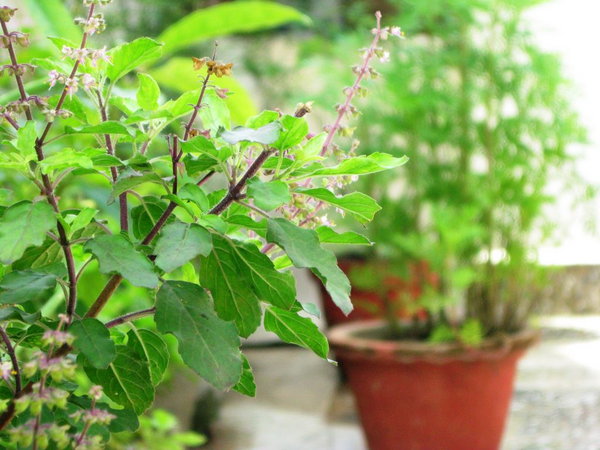Tulasi Vivah
Tulsi Vivaah is the
mythical marriage of Sri Krishna, an incarnation of Lord Vishnu with the tulsi
plant (holy basil). In the Hindu mythology, tulsi is considered to be an
incarnation of Goddess Lakshmi, and therefore unison of Gods and Goddesses is
observed with great pomp and show all over the country.
Tulsi Vivaah is
celebrated on the Dwadashi (12th day) of the Shukla Paksha (bright fortnight)
during the month of Kartik, as per the Hindu calendar. Even though this
ceremony can be observed any time between the Prabodhini Ekadashi (11th day) to
Kartik Poornima. In some places it is celebrated for a period of five days,
ending on the full moon day of the Kartik month. Tulsi Vivaah marks the end of
the monsoon season and the start of the Hindu wedding season. The actual day of
Tulsi Vivaah differs from one region to another.
The Tulsi Vivaah
puja is observed by married women all over India for the well-being of their
husband and family members. The tulsi plant is considered by the Hindus and
Tulsi herself is believed to be an incarnation of Goddess Mahalakshmi, who was
earlier born as ‘Vrinda’. Young women pray to Goddess Lakshmi with full
devotion to seek marital bliss. Tulsi Vivaah rituals are also observed by
young, unmarried women to get good husbands.
Normally
the expenses of the Tulsi Vivaah are borne by couples without daughters. They
act as parents of tulsi and perform the ‘kanyadaan’, a ceremony of giving away
their daughter tulsi to Lord Vishnu. In the Tulsi Vivaah ceremony all the
bridal offerings are then given away to a Brahmin priest. Just like any Hindu
marriage ceremony, Tulsi Vivaah is also commemorated with full enthusiasm and
fervour. By performing this auspicious marriage ceremony, women desire to bring
happiness, prosperity and wealth in their life. Tulsi Vivaah celebrations are
held in various temples all over India with great grandeur. The celebrations
are much more elaborate in the two Lord Rama temples in Saurashtra. A suitable
wedding invitation is sent from the bride’s temple to the groom’s temple. A
grand barat accompanied by dancing and singing devotees is received by the
bride’s side. It is a popular belief that childless couples, who perform
Tulsi’s kanyadaan, will soon be blessed with kids. Bhajans are sung all
throughout the day and night and the ceremonies come to an end when Lord Vishnu
along with his bride Tulsi comes back home. The Tulsi Vivaah is an ideal
example of an Indian marriage.
Rituals
of Tulsi Vivaah:
- The marriage ceremony of the Lord Krishna with Tulsi resembles much like any traditional Hindu wedding. The rituals are observed in various temples; however one can easily perform the Tulsi Vivaah at their home.
- The observer of the Tulsi Vivaah must keep the fast till the evening, when the actual ceremonies begins.
- An attractive mandap is made around the tulsi plant suing the sugarcane stalks and is decorated with colourful rangoli. The tulsi plant is then beautifully adorned with bright sari, earrings and other ornaments just like an Indian bride. Vermillion powder and turmeric is also applied on the tulsi plant. A face drawn on a paper is put on the Tulsi plant to which, nose-ring and a bindi is also attached.
- The groom is depicted either as a brass idol or picture of Lord Vishnu. Sometimes even the ‘Shaligram Stone’, symbolic of Lord Vishnu is used for the puja. The image of Lord Krishna/Vishnu is then covered in a dhoti.
- A special vegetarian lunch is prepared for this grandeur occasion. In most of the household’s puris, rice and dal, red pumpkin vegetable and a delicious sweet potato kheer is prepared. The prepared food is then kept aside for ‘bhog’ after the completion of marriage rituals.
- The actual ceremony starts in the evening. As a part of the vivaah ceremony, both Lord Vishnu and Tulsi are given a bath and adorned with flowers, before the wedding. A yellow thread is used to link the couple together for the ceremony.
- The tulsi Vivaah ceremony can either be performed by a priest or women in the house collectively perform the puja. The ritual can be performed by women of all age groups, but only widows are not allowed to participate in the tulsi Vivaah ceremony. The mantras are enchanted all throughout the wedding ceremony. At the completion of the marriage rites, the devotees shower rice mixed with vermillion on the newlyweds.
- After the puja, a tulsi aarti is sung. Once the aarti is finished, the cooked food is offered as ‘bhog’ together with fruits. The prasad is then eaten together with family members and other guests.
- A person who observes the Tulsi Vivaah should also eat a Tulsi leaf that is symbolic of Goddess Tulsi entering the devotee’s body. Prasad in the form of sweets are then distributed among all.
2016 date : 11th November, Friday.
2017 Date : 1st November.








Post a Comment